Old-School Muscle: Full-Body Training Tips

Full-body training tips from Arnold
and other Golden Age bodybuilders
Believe it or not, there was a time when many gyms were only open on Monday, Wednesday, and Friday. I’m serious. Why, you may ask?
It was because of the incredible popularity of full-body sessions. In the pre-1960s, nearly everyone trained three days a week on a full-body workout. The Monday/Wednesday/Friday split was the go-to for the vast majority of lifters. Now, if your schedule was different and you were forced to train on Tuesday, Thursday, and Saturday, I’m honestly not sure what you would do. But thankfully that’s no longer a concern in the 21st century. You can train 24 hours a day on any of the seven days of the week you like!
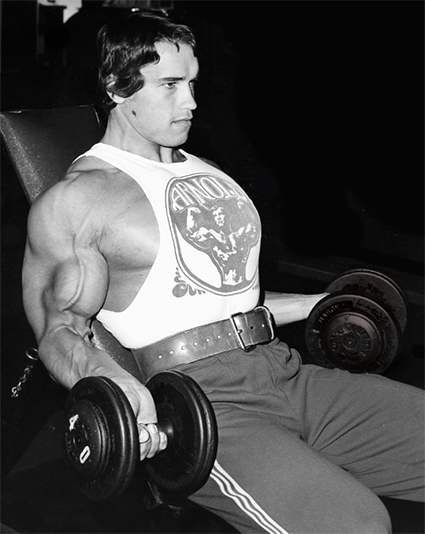
Yes, there was a time when split training was unheard of. It simply wasn’t done. The body was trained as a whole, a single unit. We trained, and then we rested, ate, and recuperated for the next session. In the decades since full-body training, literally thousands of routines have been used. Many are excellent too, but in the race to have the newest training fad that promised nearly overnight transformations, we lost sight of the full-body split.
Now before you say, “Oh that’s old fashioned,” or “That’s just for beginners,” or “I’ve been training for too many years to make progress on such a limited routine,” hold on. Take a step back in time with me for a second. Full-body sessions were the cornerstone of training from the turn of the century (no, not the year 2000 … the last century!) up until the mid to late 1960s. So just how did the best bodybuilders in that era train?

The Golden Age of Bodybuilding Approach
The era of Steve Reeves, Reg Park, John Grimek, Clancy Ross, and Vince Gironda is considered to be the golden age of bodybuilding. It was the time of the original muscle beach in Santa Monica. This was the heyday of the health and fitness movement, when bodybuilders were not only impressive to look at but also possessed great strength. Many bodybuilding contests included a weightlifting part in addition to the physique round. Health was paramount, and bodybuilding led the charge for a new, healthy worldview. Today the sport focuses on mass and conditioning, but back then, an equal amount of focus was put on being healthy. This is something we should never have lost sight of, in my opinion.
These champs used no drugs (or extremely low dosages in later years), yet they built amazing bodies. No one could look at a pic of Steve Reeves and say he didn’t have an incredible physique. Even by today’s standards, he shines. In fact, I bet the average man on the street would much rather look like Reeves than look like Big Ramy. He was lean and symmetrical, with huge shoulders, a wasp waist, full quads, and chiseled arms. Damn near flawless, and he built that body completely on the full-body workout system.

And Steve built his body when supplements basically didn’t exist. Brewer’s yeast and Knox gelatin were the big craze. GNC was decades away from existing. Even protein powders were in their infancy, and many were dried fish powder or low-grade soy. The taste of these shakes was nearly unbearable. Plus, they were extremely low in protein. It was cheaper and better to just eat eggs and drink milk. As for gyms, well, they also were basically nonexistent, at least by today’s standards. Machines we take for granted didn’t exist. Leg extensions and leg curls were high tech! So, with all this stacked against them, guys such as Reeves and Park built physiques that are still admired today. Imagine what you could achieve with today’s diet knowledge, supplements, and gym equipment!
Back in the golden age of bodybuilding, athletes didn’t train arms. They didn’t train legs. They trained the body as one unit, and when you think about it, there’s a simple, straightforward logic to that approach. The body grows as a whole and then rests as a whole. With a day of rest to recharge, the athlete approaches another session with renewed vigor. Because only one day is given between sessions, the sessions themselves must, by necessity, be limited in volume and focus on the biggest “bang for your buck” movements.
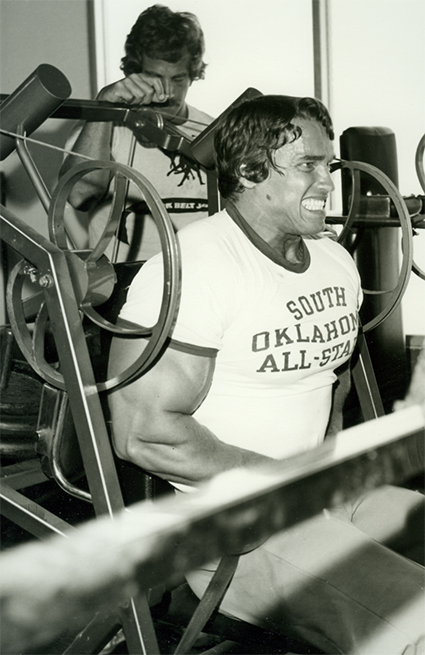
Should you do endless sets of leg extensions? No.
Would you squat hard and heavy? Yes.
A few isolation exercises after the main mass-builders is fine, and in fact needed for complete development, especially once you have built some level of muscle mass. But the focus is on efficiency and recovery. The majority of your effort will be directed into the heavy hitters, the mass-maker hall of fame exercises:
The squat.
The deadlift.
The bench press.
The pull-up.
The row.
These were the keys to the success of the early bodybuilders, and just as they helped Steve Reeves forge Herculean muscle mass, they can help us add slabs of muscle this winter season.

These key mass moves not only make for great training efficiency but also release the most testosterone and growth hormone. The full-body moves such as deadlifts also condition the body and assist in fat burning if rest periods are kept low. Squats, in fact, are a form of high intensity interval training (HIIT) when done for high reps. Several sets of 20 to 40 reps of squats with a challenging weight will definitely burn fat and condition the body. Traditional weight-training movements aren’t generally thought of as HIIT compatible, but the truth is you can burn a massive number of calories and fat if you do deadlifts and squats with conditioning in mind. For the sake of this article, most of the exercises will be focused on muscle building and not fat burning. But it’s good to keep in mind that a few high-rep sets to finish off the workout do go a long way to building cardiovascular density and conditioning.
What the champs got with these early full-body sessions is a time-efficient method to build muscle, a cardiovascular component too, and ample rest for the body to rebuild. It worked for them, and it will still work for you. That’s a promise. Their individual training styles did of course vary. Although they all grew on full-body sessions some such as Reg Park preferred to not train to failure, whereas Steve Reeves trained with near-Mentzer-like intensity. You have to see what works best for you. Personally, I prefer a phased approach to training, going from high-intensity training to lower sub-failure training.

Efficiency, ample rest, and diet—these are key factors for any natural athlete. When drugs are introduced, recovery is greatly increased. It’s no small coincidence that the explosion of split training corresponded with the explosion in drug use and the resulting superhuman sizes that began to appear in the late ’60s and up unto modern times.
But assuming we don’t want to use illegal and potentially dangerous drugs to simply look better at the beach or win a local bodybuilding show, then what is a natural trainer to do? Focus on recovery, focus on efficiency, and focus on key lifts—something that’s best achieved with full-body training. Those old-timers knew a thing or two about maximizing muscle gain with limited equipment.

The champs of yesteryear were the pioneers. They went first. They were the explorers sailing to new lands. Some of their ideas ended up going nowhere, and some were even counterproductive, but these bodybuilders learned in the trenches and from real-world training what worked and what didn’t. They didn’t need double-blind, peer-reviewed studies to know if something worked. They knew it worked because they got stronger and more muscular. Today, some call that “bro science.” I call it real-world training and life in the trenches.
Kris Gethin sums up my feelings on the subject of real-life training versus studies with this amazing quote: “Knowledge without mileage is bullshit.” I have a Kaged Muscle shirt that says that. It’s one of my favourite quotes and favourite shirts.
But don’t get me wrong—I love studies and read many of them. But put your trust in what works in real life and in real gyms.
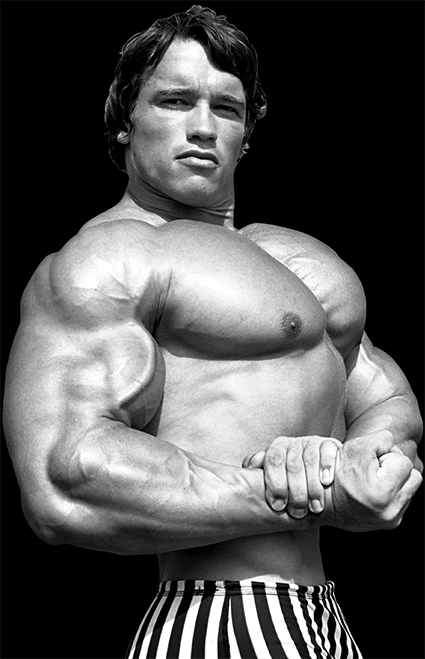
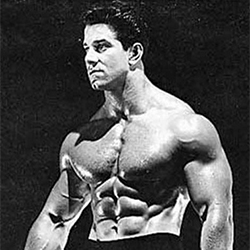 Arnold’s Idol:
Arnold’s Idol:
The Reg Park System
Reg Park was a pioneer in the sport. He was the man who inspired Arnold to first pick up a barbell. Imagine, without Reg, we wouldn’t have The Terminator. That alone is worthy of praise. Park trained almost exclusively using full-body sessions. Here’s one of his favourites using his 5 × 5 approach, an approach still popular with many strength athletes. In the Reg Park 5 × 5 program, the first 2 sets are warm-ups and the last 3 are work sets. Reg also avoided training to failure:
Workout 1:
Squats 5 × 5
Chin-Ups or Pull-Ups 5 × 5
Dips or Bench Press 5 × 5
Barbell Curls 2 × 10
Wrist Work 2 × 10
Calves 2 × 15–20
Workout 2:
Front Squats 5 × 5
Rows 5 × 5
Standing Overhead Press 5 × 5
Deadlifts 5 × 5
Wrist Work 2 × 10
Calves 2 × 15–20
Reg would alternate the two workouts, training three days per week. Arnold Schwarzenegger started his weight-training odyssey on a Reg Park full-body workout. Reg did have a few variations to the above routine, including a more detailed phase training approach, but the above one was the template for his 5 × 5 system.
We can learn so much from the pre-steroid champs that it’s unfortunate more people don’t look to the history books and see why the champs trained a certain way. See their theories and their trials, tribulations, success and failures. I encourage all my readers to research the history of the sport. It’s fascinating, and you’d be surprised how many ideas being touted as new are just rehashed versions of ideas that bodybuilding icons such as Arnold's mentor Reg Park and the legendary Steve Reeves were doing decades before you were even born!

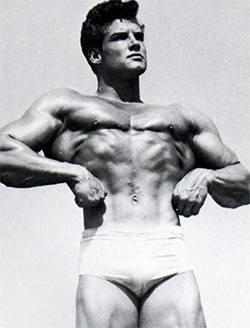 Steve Reeves’ Full Hercules Training
Steve Reeves’ Full Hercules Training
Steve Reeves was a legendary bodybuilder and one of the first to focus on symmetry. After retiring from the sport, he became an actor. He was the number one box office draw worldwide by 1960. He is best remembered as Hercules. His contest wins included Mr. America, Mr. World, and Mr. Universe. He always trained on the full-body system and built a physique that’s still impressive even by today’s standards. Here is a sample of his routine from the early 1950s:
The Steve Reeves Routine
|
Dumbbell Swings (warm-up): 3 sets of 15–20 reps |
|
Upright Rows: 3 sets of 8–12 reps Behind-the-Neck Press: 3 sets of 8–12 reps |
|
Bench Press: 3 sets of 8–12 reps |
|
One-Arm Dumbbell Rows: 3 sets of 8–12 reps |
|
Dumbbell Lateral Raises: 3 sets of 8–12 reps |
|
Incline Bench Press: 3 sets of 8–12 reps |
|
Triceps Press-Downs: 3 sets of 8–12 reps |
|
Barbell Curls*: 3 sets of 8–12 reps |
|
Seated Dumbbell Curls*: 3 sets of 8–12 reps |
|
Squats (super set with next move): 3 sets of 8–12 reps |
|
Pull-Overs: 3 sets of 8–12 reps |
|
Breathing Squats or Hack Squats (superset with next move): 1 set of 20 reps |
|
Breathing Pull-Overs: 1 set of 20 reps |
|
Deadlifts: 2 sets of 8–12 reps |
|
Good Mornings: 2 sets of 8–12 reps |
*In later years, Steve would just do incline dumbbell curls for biceps. The incline was his favourite move, and he often did 9 sets of it for biceps. The incline definitely hits the biceps stretch position and isolates the biceps; many studies have been done on the positive effects that weighted stretch moves have on muscle growth.
Reeves was famous for his intensity. He was an early version of Mike Mentzer in many respects, training to failure, often doing forced reps and even negatives before such terms were even coined. When doing incline curls, he would train to failure then use his legs to kick the dumbbells up to his shoulders before slowly lowering the weighs in a negative-only style.

Arnold Schwarzenegger’s Golden Six
The Austrian Oak began his bodybuilding journey on full-body workouts, and he still suggests them to beginners. He called it the “golden six” routine and believed these were the best mass movements you could do.
Squats: 4 sets of 10 reps
Wide-Grip Bench Press: 3 sets of 10 reps
Pull-Ups: 3 sets to failure
Behind-the-Neck Barbell Press: 4 sets of 10 reps
Barbell Curls: 3 sets of 10 reps
Bent-Knee Sit-Ups: 3–4 sets to failure
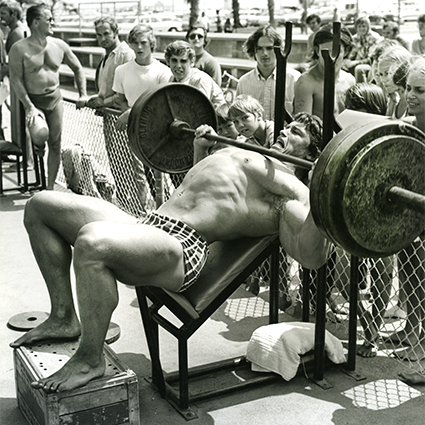
This workout was to be done three days per week on non-consecutive days.
I would suggest adding in one calf move and one triceps move to the above, myself. Far be it from me to criticize Arnold’s approach, but those two moves wouldn’t add too much extra volume, and both body parts are so important. Along the same lines, adding a direct hamstring move would be of value too. You could do stiff-legged deadlifts on Wednesday, and squats on Monday and Friday, for example.
Click HERE to sign up for our free newsletter!


